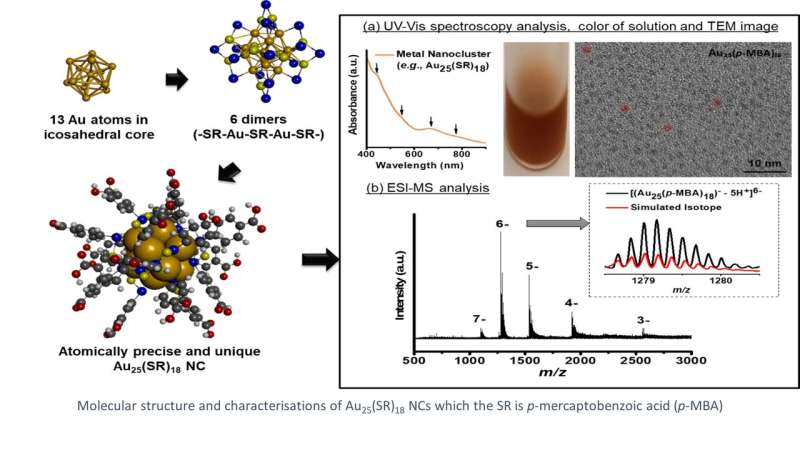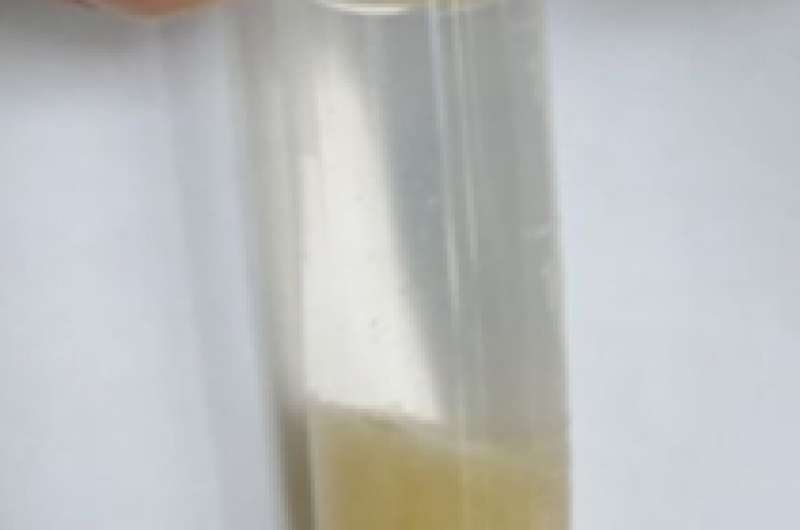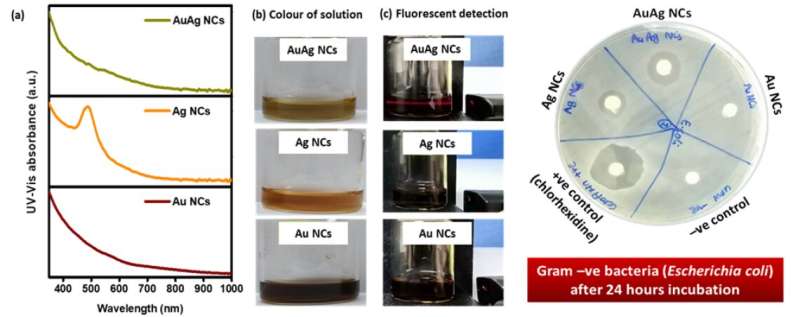Molecular structure and characterisations of Au25(SR)18 NCs which the SR is p-mercaptobenzoic acid (p-MBA). Credit: International Islamic University Malaysia (IIUM)
Noble metal nanoparticles, such as gold and silver, are well known in the research field of catalysis and biomedical applications. For example, gold and silver nanoparticles can be good catalysts for various chemical transformations, such as hydrogenation and oxidation. They can also be used for bioimaging, and as drug carriers and radiosensitizers in cancer therapy due to their optical properties and biocompatibility. Silver nanoparticles have been widely researched and used in commercial products for their antimicrobial activity towards a broad spectrum of microorganisms.
They do have some limitations, though. Better molecular-scale insight into their behavior is difficult due to their varying sizes in the dispersed phase. Thanks to the advancement of nanoscience and nanotechnology, various new nanomaterials have been produced with interesting physicochemical properties that benefit a myriad of applications. This includes ultrasmall metal nanoclusters (size < 2 nm), which can be obtained with high uniformity of particle size in the dispersed phase, high atomic precision and consistent molecular structure. Various gold nanoclusters have been produced, crystallized and characterised. One of the most intensively studied is atomically precise thiolate-protected gold nanoclusters. There are several gold nanoclusters that have been reported. Among them thiolate-protected Au25SR18 NCs are the most intensively studied. The molecular understanding of Au25SR18 NCs has been well established by using X-ray crystallography, electrospray ionization spectroscopy, molecular dynamics and density functional theory analyses.
In general, the physicochemical properties of gold nanoclusters are different from their nanoparticle counterparts because of their ultrasmall size (<2 nm and <150 gold atoms), making them more reactive, having a higher surface area to volume ratio and higher atomic utilization. This means that the more gold atom can be utilized efficiently. The ultrasmall size also contributes to quantum confinement effects. Unlike plasmon gold nanoparticles, which have continuous or semi-continuous energy levels, gold nanoclusters have a distinctive discrete electronic structure and molecular-like properties, such as enhanced photoluminescence, intrinsic magnetism, intrinsic chirality and discrete redox behavior. Also, the physicochemical properties of gold nanoclusters are more size- and atomic-dependent than gold nanoparticles, which have a collective nature. Therefore, these properties can be tuned remarkably by ligand and metal engineering. Examples of ligand engineering include varying the number and composition of ligands, and modifying ligand types, length and functional groups. Metal engineering can involve varying metal number and composition. These strategies are useful for engineering ligand-protected gold nanoclusters.
-
Au NCs immobilized on chitin extracted from shrimp shell wastes. Credit: International Islamic University Malaysia (IIUM)
-
Comparisons between gold-silver nanoclusters (AuAg NCs) and the single metal nanoclusters such as silver nanoclusters (Ag NCs) and gold nanoclusters (Au NCs) in terms of optical properties, based on UV-Vis analysis (a), colour of solution (b) and photoluminescent property (d) and antimicrobial activity toward gram negative bacteria, E.coli (based on inhibition zone of the agar diffusion test ). Credit: International Islamic University Malaysia (IIUM)
IIUM researcher Dr. Ricca Rahman Nasaruddin has been working on Au25SR18 NCs for catalysis since her doctorate study and has established a molecular understanding of the roles of ligands in catalytic accessibility, activity, reaction pathway and reaction mechanism. Currently, she and her colleagues are working on improving the stability of the metal nanocluster catalysts by immobilizing them on several support materials that can be obtained from agricultural and manufacturing wastes. For example, immobilized gold nanoclusters on chitin extracted from shrimp shell waste has improved the recyclability of the gold nanocluster catalysts in 4-nitrophenol hydrogenation in solution as compared to free gold nanoclusters, which cannot be recovered after the catalytic reaction.
"Alloy gold-silver nanoclusters have better antimicrobial activities compared to the single gold and silver nanoclusters," says Dr. Ricca Rahman Nasaruddin.
They are also working on producing gold-silver alloy nanoclusters protected by glutathione for antimicrobial applications. This new alloy nanomaterials can be further used in various antimicrobial-based application such as wound dressings and disinfectant. In addition, the alloy gold-silver nanoclusters also show photoluminescent properties that can be further studied for theranostic applications. Nasaruddin's research team is also investigating the potential of gold nanoclusters in the development of diagnostics and nanocosmetics.
Provided by International Islamic University Malaysia (IIUM)

























